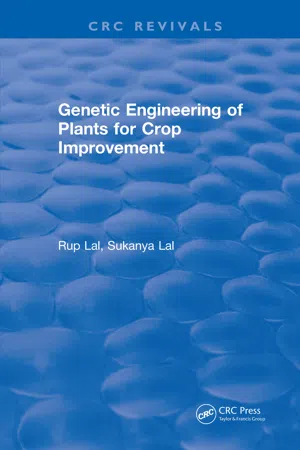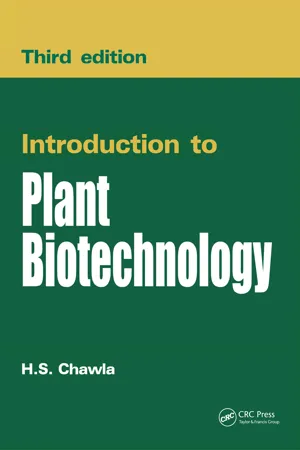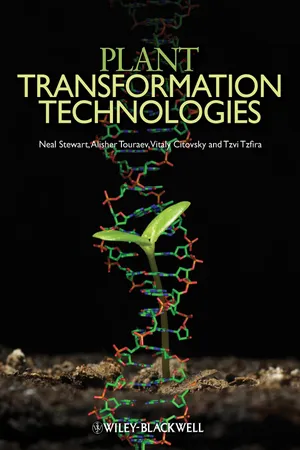Biological Sciences
Plant Vector
A plant vector is a tool used in genetic engineering to introduce foreign genes into plant cells. It is typically a small, circular DNA molecule that can replicate independently within the plant cell. Plant vectors often contain genetic elements such as promoters and selectable markers to facilitate the expression and identification of the introduced genes.
Written by Perlego with AI-assistance
Related key terms
Related key terms
1 of 4
Related key terms
1 of 3
4 Key excerpts on "Plant Vector"
- Rup Lal(Author)
- 2020(Publication Date)
- CRC Press(Publisher)
Chapter 1Gene Transfer Methods for Crop Improvement
I Introduction
Plant breeders and genetic engineers share the common goal of plant improvement. While plant breeders traditionally use selective breeding for varietal enhancement, genetic engineers continue to develop techniques for the isolation and insertion of genes for desirable traits. Genes which are unavailable to a particular plant species due to sexual incompatibility may be obtained from other organisms (plants, microorganisms, or animals) and transferred into plants.Several steps using both molecular and cellular biology techniques are involved in producing a genetically engineered plant. A trait must be chosen and the gene(s) encoding the trait identified and isolated from a donor organism. The functional gene must include regulatory regions in order to be correctly expressed in the plant. The isolated gene may be transferred directly or inserted into vectors. For successful transformation the gene sequences introduced into the plant cell must be inserted into the plant genome, expressed, and maintained throughout subsequent cell divisions. Finally, the transformed plant cells must be regenerated into whole plants. Various gene transfer methods which introduce DNA sequences into plant cells will be discussed in this chapter.II Plant Viruses as Biological Vectors
Certain naturally occurring plant DNA viruses can be used to introduce DNA into normal, healthy plants. Viral vectors and their application in gene transformation in plants have already been described in detail.1 Among all viral vectors, cauliflower mosaic virus (CaMV) is becoming very popular. CaMV, a caulimovirus, contains double-stranded DNA which lends itself easily to the manipulations involved in recombinant DNA technology. The ability of CaMV to infect plants and then move systematically through the host avoids the need for cell culture. Plants can be inoculated by rubbing the leaves with engineered CaMV. One region of the CaMV genome (gene II) has been shown to be dispensable for viral replication. When this gene is replaced with a bacterial gene the resulting engineered CaMV is able to systematically infect and express the bacterial gene in inoculated plants.1- eBook - ePub
Genetically Engineered Viruses
Development and Applications
- Dr Eddie Blair, Dr Chris J A Ring(Authors)
- 2023(Publication Date)
- Garland Science(Publisher)
Chapter 4 Plant viruses Christophe Lacomme, Greg P. Pogue, T. Michael A. Wilson and Simon Santa Cruz4.1 Introduction
Progress in the understanding of plant virus gene regulation has provided a diverse collection of tools that are routinely exploited in both basic and applied plant molecular biology. Regulatory elements have been derived from both RNA and DNA plant viruses that have found widespread application in transgenic plant technology (Mushegian and Shepherd, 1995). For example the cauliflower mosaic virus (CaMV) 35S promoter and the tobacco mosaic virus (TMV) Ω translational enhancer are routinely used to direct and regulate transgene expression. In addition to their utility as ‘toolboxes’ in providing sequences of value in plant genetic engineering plant viruses also offer the possibility of providing convenient and readily manipulated vectors for the rapid and high-level expression of foreign genes in plants. To date the most widespread application of plant virus-based vectors has been in the area of basic research and less attention has focused on the potential of virus-based vectors in commercial biotechnology. In part the emphasis on viral vectors as research tools reflects the successes achieved in the development of stable transformation technologies for plants. Techniques for Agrobacterium-mediated transformation and more recently biolistic introduction of foreign genes that are effective in a wide range of agronomically important species have been developed over the last 15 years. The products of these novel molecular breeding technologies are now commercially available and include agronomically valuable traits, such as herbicide tolerance, disease resistance and pest resistance (Birch, 1997 ). In addition to agronomic improvement transgenic plants also have the potential for exploitation as bioreactors for the bulk production of desirable proteins (for reviews see:Fischer et al., 1999a; 1999b; Porta and Lomonossoff, 1996 - eBook - ePub
- H S Chawla(Author)
- 2011(Publication Date)
- CRC Press(Publisher)
23 Gene Transfer in Plants Gene transfer or DNA uptake refers to the process that moves a specific piece of DNA (usually a foreign gene ligated to a bacterial plasmid) into cells. In plant breeding, techniques involving gene transfer through sexual and vegetative propagation are well established, the aim being to introduce genetic diversity into plant populations, to select superior plants carrying genes for desired traits and to maintain the range of plant varieties. The application of these conventional or classical techniques has produced significant achievements in the yield improvement of major food crops. However, this takes a long time. For example, it usually takes 6–8 years to produce a new variety of wheat or rice by sexual propagation. With the rapid development of genetic engineering techniques based on the knowledge of gene structure and function, plant breeding has been dramatically broadened. The directed desirable gene transfer from one organism to other and the subsequent stable integration and expression of a foreign gene into the genome is referred as genetic transformation. The transferred gene is known as transgene and the organisms that develop after a successful gene transfer are known as transgenics. Transgenic plants are the plants that carry the stably integrated foreign genes. These plants may also be called transformed plants. In vitro gene transfer is the laboratory technique of transferring refined desirable genes across taxonomic boundaries into plant and animals from other plants, animals and microbes, or even to introduce artificial, synthetic or chimeric genes into plants. The development of gene transfer techniques in plants has been very rapid. The techniques presently available rely upon natural Plant Vectors as well as vectorless systems, which include directed physical and chemical methods for delivering foreign DNA into plant cells - eBook - ePub
- Charles Neal Stewart, Alisher Touraev, Vitaly Citovsky, Tzvi Tzfira, Charles Neal Stewart, Alisher Touraev, Vitaly Citovsky, Tzvi Tzfira(Authors)
- 2011(Publication Date)
- Wiley-Blackwell(Publisher)
E. coli , high cloning capacity, Gateway recombination sites, improved compatibility with the strains of choice, a wide pool of selectable markers, a high frequency of transformation, and so on. While classic vectors are still sufficient for many applications, improved vectors exhibit various user-friendly features. Vectors that are specifically designed to resolve certain regulatory issues, such as the removal of marker genes and reduction of transfer of the vector backbone, are also available. It is likely that the improvement of vectors will be continued as new technical demands arise in the plant science community. Although it is not difficult to find a vector that can somehow be used in a particular experiment, a further search for vectors better suited to the experimental purpose is often very useful.ReferencesAn G, Watson BD, Stachel S, Gordon MP, Nester EW (1985) New cloning vehicles for transformation of higher plants. The EMBO Journal 4, 277–284.Bevan M (1984) Binary Agrobacterium vectors for plant transformation. Nucleic Acids Research 12, 8711–8721.Chan PT, Ohmori H, Tomizawa J, Lebowitz J (1985) Nucleotide sequence and gene organization of ColE1 DNA. The Journal of Biological Chemistry 260, 8925–8935.Chang SS, Park SK, Kim BC, Kang BJ, Kim DU, Nam HG (1994) Stable genetic transformation of Arabidopsis thaliana by Agrobacterium inoculation in planta . The Plant Journal 5, 551–558.Chen H, Nelson RS, Sherwood JL (1994) Enhanced recovery of transformants of Agrobacterium tumefaciens after freeze-thaw transformation and drug selection. BioTechniques 16, 664–670.Christensen AH, Sharrock RA, Quail PH (1992) Maize polyubiquitin genes: structure, thermal perturbation of expression and transcript splicing, and promoter activity following transfer to protoplasts by electroporation. Plant Molecular Biology 18, 675–689.Conner A, Barrell P, Baldwin S, Lokerse A, Cooper P, Erasmuson A, Nap J-P, Jacobs J (2007) Intragenic vectors for gene transfer without foreign DNA. Euphytica
Index pages curate the most relevant extracts from our library of academic textbooks. They’ve been created using an in-house natural language model (NLM), each adding context and meaning to key research topics.
Explore more topic indexes
Explore more topic indexes
1 of 6
Explore more topic indexes
1 of 4



